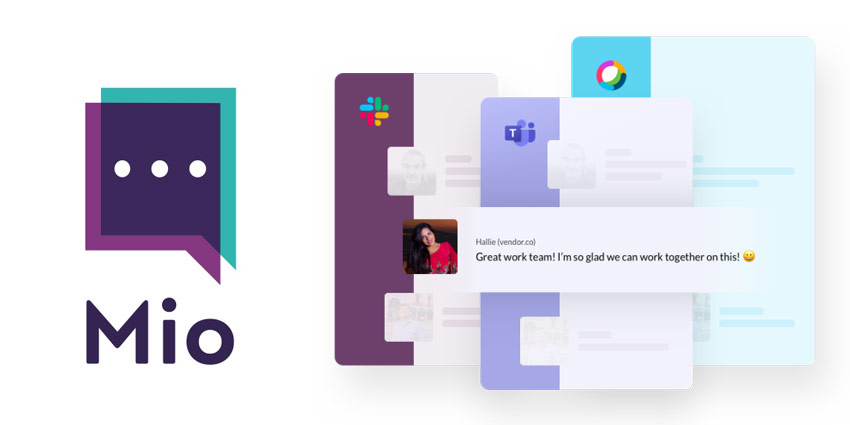We’re quickly discovering that inter-office phone calls and emails aren’t the best way to stay connected in an environment that’s becoming increasingly agile and remote.
In recent weeks specifically, companies of all sizes have been forced to find better ways of working together when individuals can’t share an office space. That’s where tools like Slack and Microsoft Teams swoop in.
These collaborative environments create an incredible space for internal employees to discuss projects and work hand-in-hand on tasks. However, there’s a problem. Collaboration tools are designed to connect internal workers. Often, external employees, clients, and contractors are ignored.
Mio has stepped in to address that problem by extending Slack’s shared channels concept to users of Microsoft Teams. Microsoft Teams users can now invite external contacts to join universal channels from any Microsoft Teams tenant or Slack workspace.
I spoke to Tom Hadfield, Mio’s CEO, about the solution.
Creating Microsoft Teams Shared Channels

Mio is committed to powering seamless communication experiences between people on Microsoft Teams, Webex Teams, and Slack. Although Mio has seen a massive response to its introduction of the new Universal Channels solution, some use cases are standing out more than others.
For instance, Hadfield told me the thing that’s really resonating in this complex time is the ability that Mio gives businesses for customers to have shared channels between Microsoft Teams users on different Microsoft tenants.
For a long time now, Slack has offered shared channels for Slack users on different Slack workspaces. However, if you wanted to connect with an external company or individual on Microsoft Teams, there’s no simple solution. Even if both of you are using Microsoft Teams, one would have to create a guest account for the other.
“Professional services companies like marketing agencies, lawyers, investment firms, and accountants are all seeing a growing need to connect with clients who use Microsoft Teams. They don’t want to rely on guest accounts, which create IT admin headaches and security risks. Until now, because Microsoft doesn’t offer a “shared channels” solution, many Teams customers are forced back to email for external communication.”
The Use Cases for Mio Universal Channels
Mio Universal Channels allows business leaders to connect their Microsoft Teams channels with external business contacts who use Microsoft Teams, Slack, or Cisco Webex Teams. As Tom told me, most of the company’s customers are Slack clients looking to talk to external customers or colleagues in Microsoft Teams.
However, as the spike in usage of Microsoft Teams continues to grow, Microsoft customers are increasingly looking for a shared channel experience in Teams as well.
Although Microsoft will likely want to create a shared channels experience eventually, that’s not an option now. This means that end user experience and security risk being compromised whenever a team is using Microsoft Teams to connect with external users.
Tom noted that Mio believes that the future of intercompany collaboration is based in channels. Channels are more searchable, open, and collaborative in nature than direct messaging. The demand for these channels is at the core of the many use cases that Mio appeals to.
“We have marketing agencies using Mio for real-time meetings with their clients through Microsoft Teams for the first time.”
“When you can do this, project timelines are accelerated, billable hours go up, and relationships blossom between agencies and their clients”
Who Benefits from Intercompany Collaboration?
Hadfield shared that numerous companies are already seeing the benefits of Universal Channels from Mio. The company is currently working with a venture capital firm that has invited its portfolio companies in a single universal channel. This has led to significant improvements in communication between companies in the investor’s portfolio.
“Anyone who’s selling business-to-business software can invite prospect clients into a universal channel to answer questions and close deals faster. We’ve seen people doing this with Slack shared channels in the past, but now Microsoft Teams customers can do this too.”
With Mio, companies unlock the benefits of team chat for internal and external colleagues alike. According to Tom, over the past few years, businesses have been training people to expect that they can engage in instant chats with their internal colleagues. With Mio, it’s becoming increasingly easy for those businesses to connect with the external marketplace and community too.
“If we all have merged spaces we can work in, our reliance on calls and emails reduces too. This is the future of work, where we can help IT administrators bring all the real-time messaging and connectivity between employees and eliminate shadow IT.”
A Future of Shared Connections
Mio believes that the future is in channels that anyone can join – not just internal employees. A lot of communication today is still happening in guest accounts with other companies, as well as shadow IT via apps like iMessage and WhatsApp.
“Mio allows you to bring all of those conversations out of the shadows, so it’s manageable and shareable. Providing a legitimate mechanism for communicating with external people improves end-user experience and security”







